Aboriginal and Torres Strait Islander Health Assignment
VerifiedAdded on 2020/04/29
|14
|4173
|78
AI Summary
Contribute Materials
Your contribution can guide someone’s learning journey. Share your
documents today.
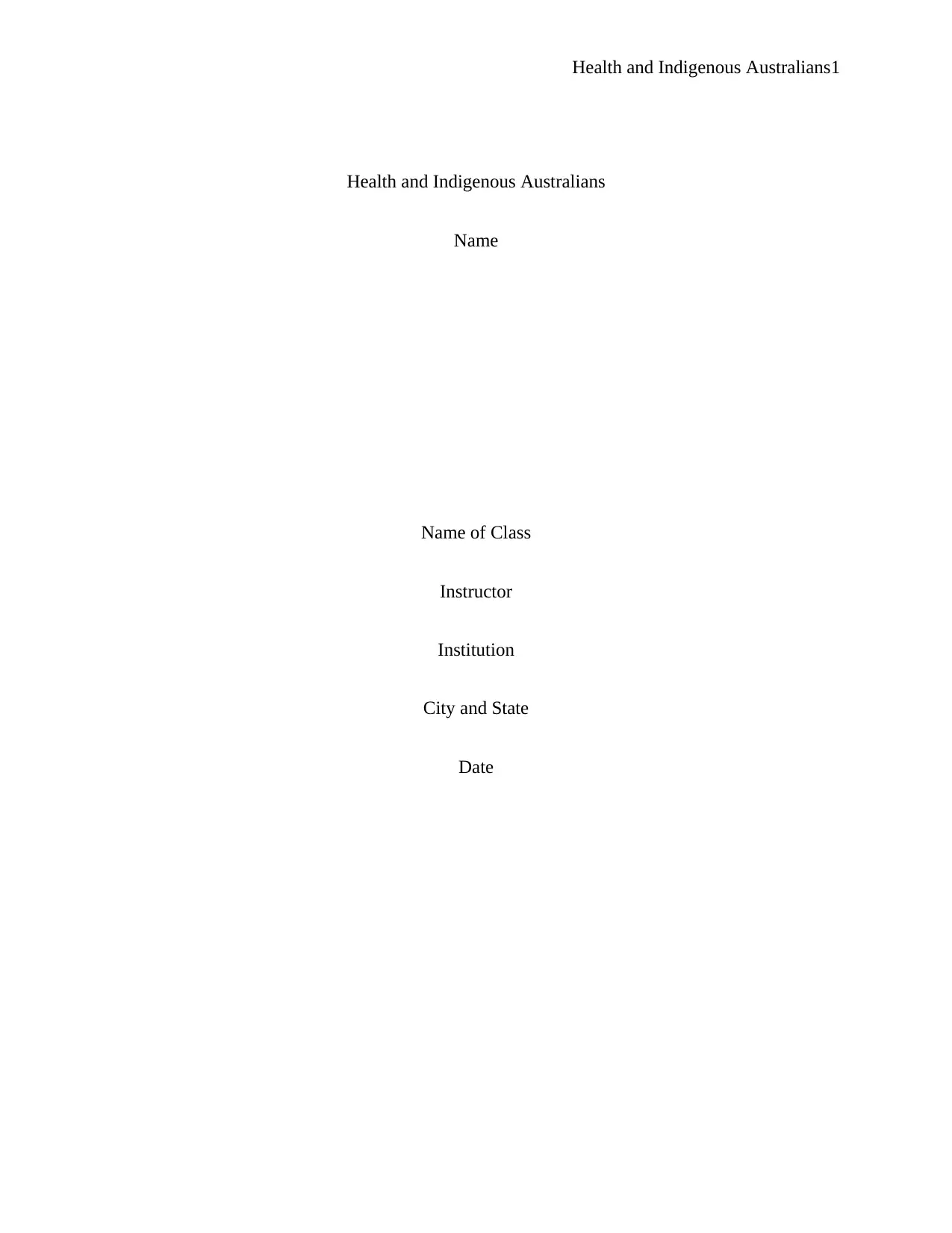
Health and Indigenous Australians1
Health and Indigenous Australians
Name
Name of Class
Instructor
Institution
City and State
Date
Health and Indigenous Australians
Name
Name of Class
Instructor
Institution
City and State
Date
Secure Best Marks with AI Grader
Need help grading? Try our AI Grader for instant feedback on your assignments.
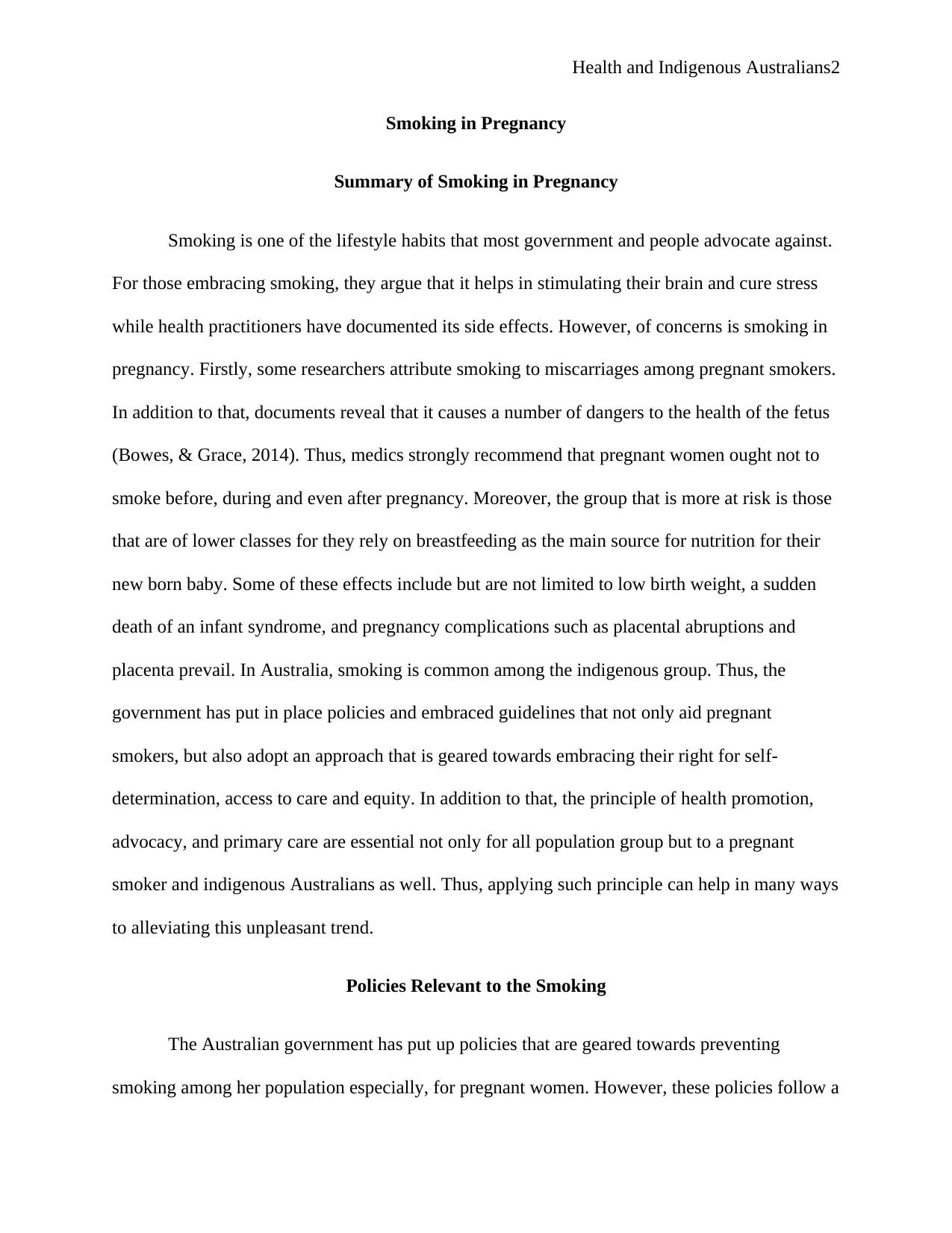
Health and Indigenous Australians2
Smoking in Pregnancy
Summary of Smoking in Pregnancy
Smoking is one of the lifestyle habits that most government and people advocate against.
For those embracing smoking, they argue that it helps in stimulating their brain and cure stress
while health practitioners have documented its side effects. However, of concerns is smoking in
pregnancy. Firstly, some researchers attribute smoking to miscarriages among pregnant smokers.
In addition to that, documents reveal that it causes a number of dangers to the health of the fetus
(Bowes, & Grace, 2014). Thus, medics strongly recommend that pregnant women ought not to
smoke before, during and even after pregnancy. Moreover, the group that is more at risk is those
that are of lower classes for they rely on breastfeeding as the main source for nutrition for their
new born baby. Some of these effects include but are not limited to low birth weight, a sudden
death of an infant syndrome, and pregnancy complications such as placental abruptions and
placenta prevail. In Australia, smoking is common among the indigenous group. Thus, the
government has put in place policies and embraced guidelines that not only aid pregnant
smokers, but also adopt an approach that is geared towards embracing their right for self-
determination, access to care and equity. In addition to that, the principle of health promotion,
advocacy, and primary care are essential not only for all population group but to a pregnant
smoker and indigenous Australians as well. Thus, applying such principle can help in many ways
to alleviating this unpleasant trend.
Policies Relevant to the Smoking
The Australian government has put up policies that are geared towards preventing
smoking among her population especially, for pregnant women. However, these policies follow a
Smoking in Pregnancy
Summary of Smoking in Pregnancy
Smoking is one of the lifestyle habits that most government and people advocate against.
For those embracing smoking, they argue that it helps in stimulating their brain and cure stress
while health practitioners have documented its side effects. However, of concerns is smoking in
pregnancy. Firstly, some researchers attribute smoking to miscarriages among pregnant smokers.
In addition to that, documents reveal that it causes a number of dangers to the health of the fetus
(Bowes, & Grace, 2014). Thus, medics strongly recommend that pregnant women ought not to
smoke before, during and even after pregnancy. Moreover, the group that is more at risk is those
that are of lower classes for they rely on breastfeeding as the main source for nutrition for their
new born baby. Some of these effects include but are not limited to low birth weight, a sudden
death of an infant syndrome, and pregnancy complications such as placental abruptions and
placenta prevail. In Australia, smoking is common among the indigenous group. Thus, the
government has put in place policies and embraced guidelines that not only aid pregnant
smokers, but also adopt an approach that is geared towards embracing their right for self-
determination, access to care and equity. In addition to that, the principle of health promotion,
advocacy, and primary care are essential not only for all population group but to a pregnant
smoker and indigenous Australians as well. Thus, applying such principle can help in many ways
to alleviating this unpleasant trend.
Policies Relevant to the Smoking
The Australian government has put up policies that are geared towards preventing
smoking among her population especially, for pregnant women. However, these policies follow a
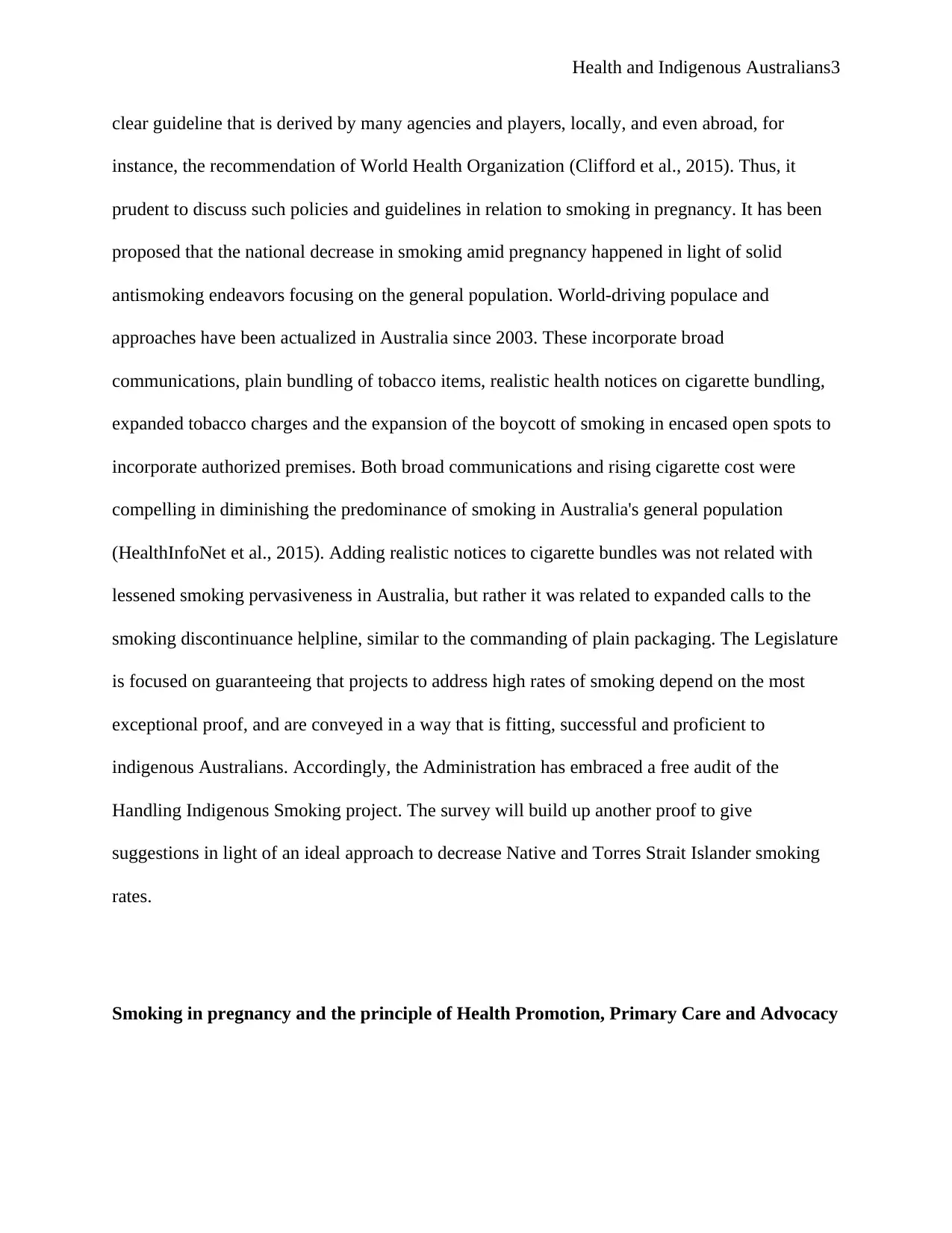
Health and Indigenous Australians3
clear guideline that is derived by many agencies and players, locally, and even abroad, for
instance, the recommendation of World Health Organization (Clifford et al., 2015). Thus, it
prudent to discuss such policies and guidelines in relation to smoking in pregnancy. It has been
proposed that the national decrease in smoking amid pregnancy happened in light of solid
antismoking endeavors focusing on the general population. World-driving populace and
approaches have been actualized in Australia since 2003. These incorporate broad
communications, plain bundling of tobacco items, realistic health notices on cigarette bundling,
expanded tobacco charges and the expansion of the boycott of smoking in encased open spots to
incorporate authorized premises. Both broad communications and rising cigarette cost were
compelling in diminishing the predominance of smoking in Australia's general population
(HealthInfoNet et al., 2015). Adding realistic notices to cigarette bundles was not related with
lessened smoking pervasiveness in Australia, but rather it was related to expanded calls to the
smoking discontinuance helpline, similar to the commanding of plain packaging. The Legislature
is focused on guaranteeing that projects to address high rates of smoking depend on the most
exceptional proof, and are conveyed in a way that is fitting, successful and proficient to
indigenous Australians. Accordingly, the Administration has embraced a free audit of the
Handling Indigenous Smoking project. The survey will build up another proof to give
suggestions in light of an ideal approach to decrease Native and Torres Strait Islander smoking
rates.
Smoking in pregnancy and the principle of Health Promotion, Primary Care and Advocacy
clear guideline that is derived by many agencies and players, locally, and even abroad, for
instance, the recommendation of World Health Organization (Clifford et al., 2015). Thus, it
prudent to discuss such policies and guidelines in relation to smoking in pregnancy. It has been
proposed that the national decrease in smoking amid pregnancy happened in light of solid
antismoking endeavors focusing on the general population. World-driving populace and
approaches have been actualized in Australia since 2003. These incorporate broad
communications, plain bundling of tobacco items, realistic health notices on cigarette bundling,
expanded tobacco charges and the expansion of the boycott of smoking in encased open spots to
incorporate authorized premises. Both broad communications and rising cigarette cost were
compelling in diminishing the predominance of smoking in Australia's general population
(HealthInfoNet et al., 2015). Adding realistic notices to cigarette bundles was not related with
lessened smoking pervasiveness in Australia, but rather it was related to expanded calls to the
smoking discontinuance helpline, similar to the commanding of plain packaging. The Legislature
is focused on guaranteeing that projects to address high rates of smoking depend on the most
exceptional proof, and are conveyed in a way that is fitting, successful and proficient to
indigenous Australians. Accordingly, the Administration has embraced a free audit of the
Handling Indigenous Smoking project. The survey will build up another proof to give
suggestions in light of an ideal approach to decrease Native and Torres Strait Islander smoking
rates.
Smoking in pregnancy and the principle of Health Promotion, Primary Care and Advocacy
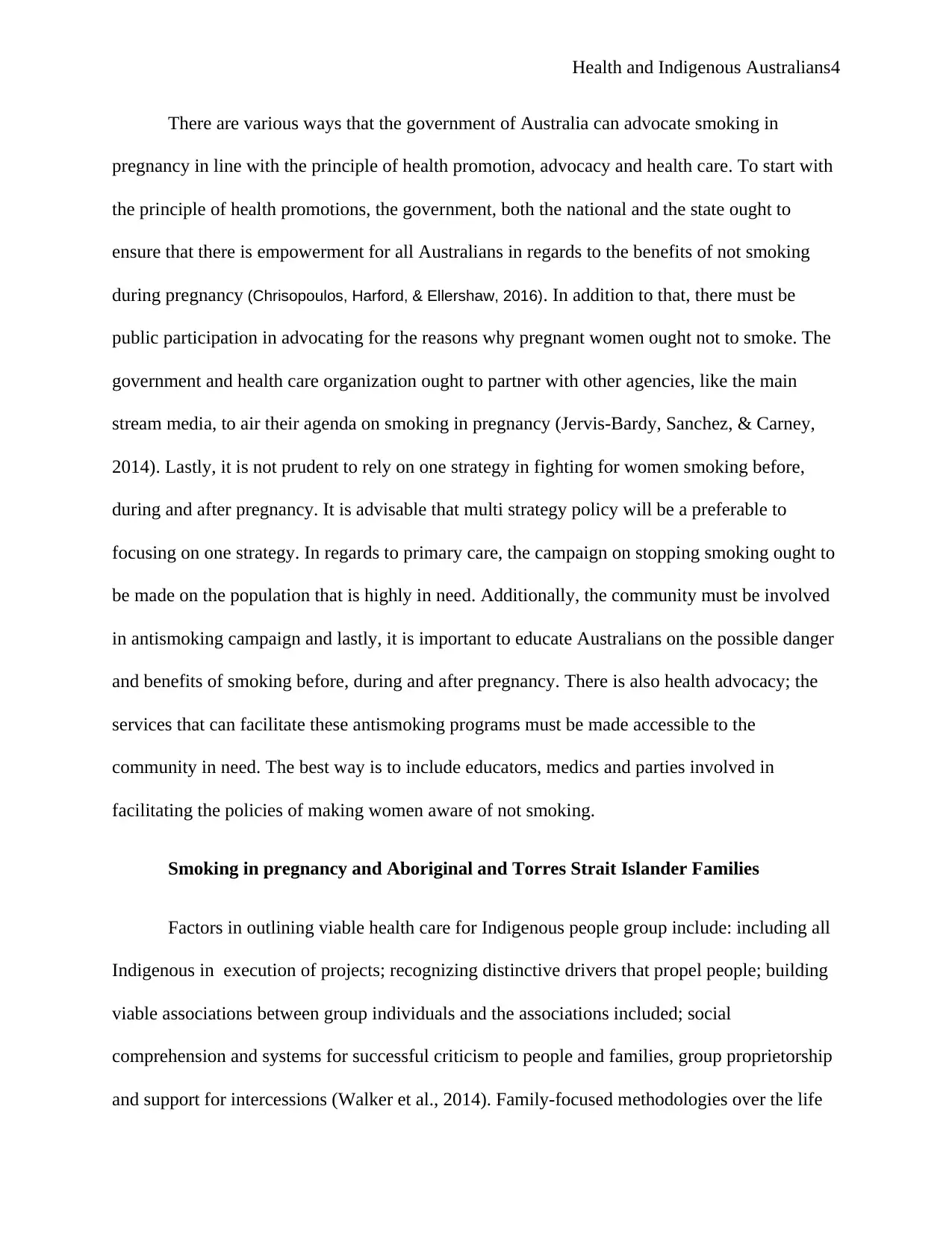
Health and Indigenous Australians4
There are various ways that the government of Australia can advocate smoking in
pregnancy in line with the principle of health promotion, advocacy and health care. To start with
the principle of health promotions, the government, both the national and the state ought to
ensure that there is empowerment for all Australians in regards to the benefits of not smoking
during pregnancy (Chrisopoulos, Harford, & Ellershaw, 2016). In addition to that, there must be
public participation in advocating for the reasons why pregnant women ought not to smoke. The
government and health care organization ought to partner with other agencies, like the main
stream media, to air their agenda on smoking in pregnancy (Jervis-Bardy, Sanchez, & Carney,
2014). Lastly, it is not prudent to rely on one strategy in fighting for women smoking before,
during and after pregnancy. It is advisable that multi strategy policy will be a preferable to
focusing on one strategy. In regards to primary care, the campaign on stopping smoking ought to
be made on the population that is highly in need. Additionally, the community must be involved
in antismoking campaign and lastly, it is important to educate Australians on the possible danger
and benefits of smoking before, during and after pregnancy. There is also health advocacy; the
services that can facilitate these antismoking programs must be made accessible to the
community in need. The best way is to include educators, medics and parties involved in
facilitating the policies of making women aware of not smoking.
Smoking in pregnancy and Aboriginal and Torres Strait Islander Families
Factors in outlining viable health care for Indigenous people group include: including all
Indigenous in execution of projects; recognizing distinctive drivers that propel people; building
viable associations between group individuals and the associations included; social
comprehension and systems for successful criticism to people and families, group proprietorship
and support for intercessions (Walker et al., 2014). Family-focused methodologies over the life
There are various ways that the government of Australia can advocate smoking in
pregnancy in line with the principle of health promotion, advocacy and health care. To start with
the principle of health promotions, the government, both the national and the state ought to
ensure that there is empowerment for all Australians in regards to the benefits of not smoking
during pregnancy (Chrisopoulos, Harford, & Ellershaw, 2016). In addition to that, there must be
public participation in advocating for the reasons why pregnant women ought not to smoke. The
government and health care organization ought to partner with other agencies, like the main
stream media, to air their agenda on smoking in pregnancy (Jervis-Bardy, Sanchez, & Carney,
2014). Lastly, it is not prudent to rely on one strategy in fighting for women smoking before,
during and after pregnancy. It is advisable that multi strategy policy will be a preferable to
focusing on one strategy. In regards to primary care, the campaign on stopping smoking ought to
be made on the population that is highly in need. Additionally, the community must be involved
in antismoking campaign and lastly, it is important to educate Australians on the possible danger
and benefits of smoking before, during and after pregnancy. There is also health advocacy; the
services that can facilitate these antismoking programs must be made accessible to the
community in need. The best way is to include educators, medics and parties involved in
facilitating the policies of making women aware of not smoking.
Smoking in pregnancy and Aboriginal and Torres Strait Islander Families
Factors in outlining viable health care for Indigenous people group include: including all
Indigenous in execution of projects; recognizing distinctive drivers that propel people; building
viable associations between group individuals and the associations included; social
comprehension and systems for successful criticism to people and families, group proprietorship
and support for intercessions (Walker et al., 2014). Family-focused methodologies over the life
Secure Best Marks with AI Grader
Need help grading? Try our AI Grader for instant feedback on your assignments.
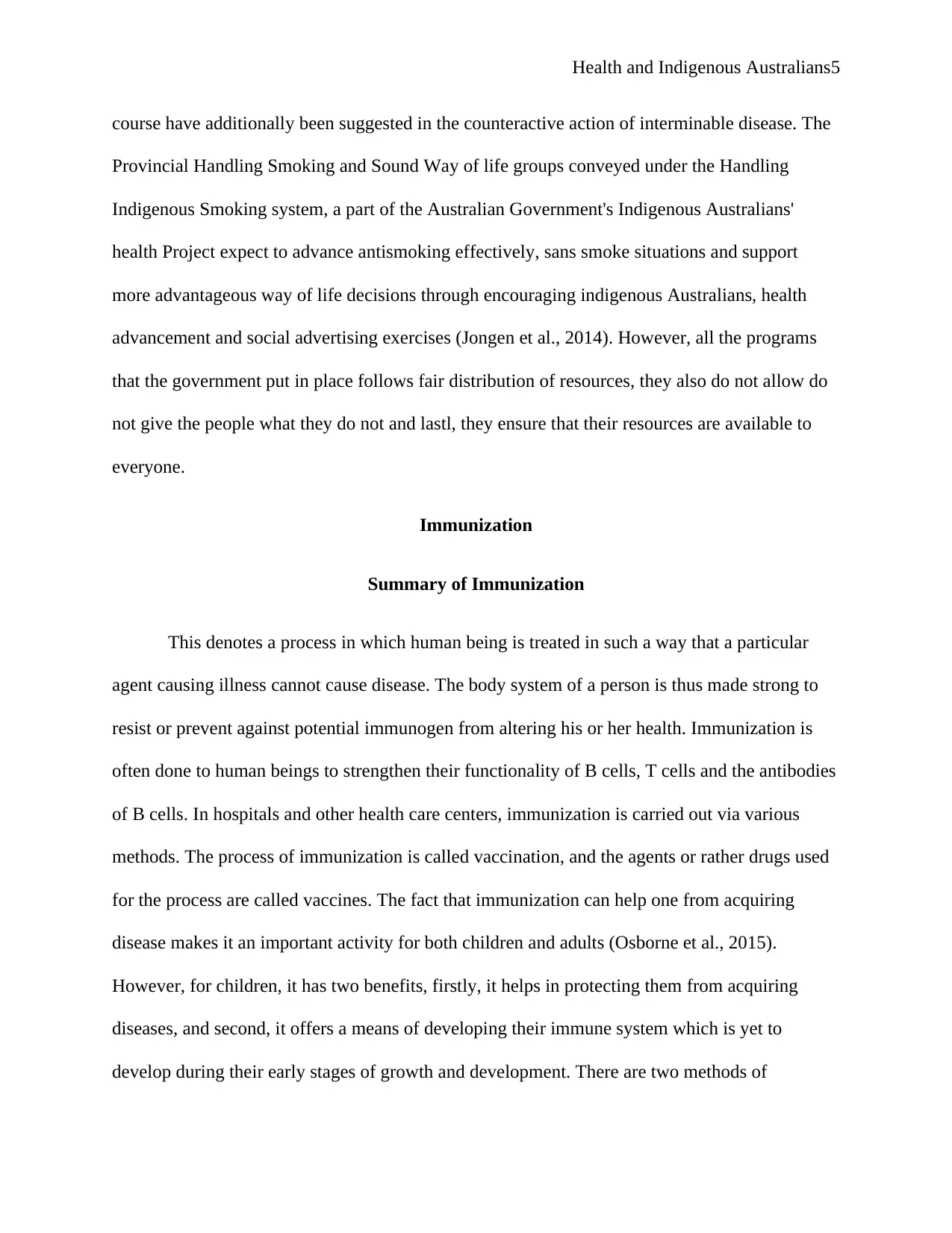
Health and Indigenous Australians5
course have additionally been suggested in the counteractive action of interminable disease. The
Provincial Handling Smoking and Sound Way of life groups conveyed under the Handling
Indigenous Smoking system, a part of the Australian Government's Indigenous Australians'
health Project expect to advance antismoking effectively, sans smoke situations and support
more advantageous way of life decisions through encouraging indigenous Australians, health
advancement and social advertising exercises (Jongen et al., 2014). However, all the programs
that the government put in place follows fair distribution of resources, they also do not allow do
not give the people what they do not and lastl, they ensure that their resources are available to
everyone.
Immunization
Summary of Immunization
This denotes a process in which human being is treated in such a way that a particular
agent causing illness cannot cause disease. The body system of a person is thus made strong to
resist or prevent against potential immunogen from altering his or her health. Immunization is
often done to human beings to strengthen their functionality of B cells, T cells and the antibodies
of B cells. In hospitals and other health care centers, immunization is carried out via various
methods. The process of immunization is called vaccination, and the agents or rather drugs used
for the process are called vaccines. The fact that immunization can help one from acquiring
disease makes it an important activity for both children and adults (Osborne et al., 2015).
However, for children, it has two benefits, firstly, it helps in protecting them from acquiring
diseases, and second, it offers a means of developing their immune system which is yet to
develop during their early stages of growth and development. There are two methods of
course have additionally been suggested in the counteractive action of interminable disease. The
Provincial Handling Smoking and Sound Way of life groups conveyed under the Handling
Indigenous Smoking system, a part of the Australian Government's Indigenous Australians'
health Project expect to advance antismoking effectively, sans smoke situations and support
more advantageous way of life decisions through encouraging indigenous Australians, health
advancement and social advertising exercises (Jongen et al., 2014). However, all the programs
that the government put in place follows fair distribution of resources, they also do not allow do
not give the people what they do not and lastl, they ensure that their resources are available to
everyone.
Immunization
Summary of Immunization
This denotes a process in which human being is treated in such a way that a particular
agent causing illness cannot cause disease. The body system of a person is thus made strong to
resist or prevent against potential immunogen from altering his or her health. Immunization is
often done to human beings to strengthen their functionality of B cells, T cells and the antibodies
of B cells. In hospitals and other health care centers, immunization is carried out via various
methods. The process of immunization is called vaccination, and the agents or rather drugs used
for the process are called vaccines. The fact that immunization can help one from acquiring
disease makes it an important activity for both children and adults (Osborne et al., 2015).
However, for children, it has two benefits, firstly, it helps in protecting them from acquiring
diseases, and second, it offers a means of developing their immune system which is yet to
develop during their early stages of growth and development. There are two methods of
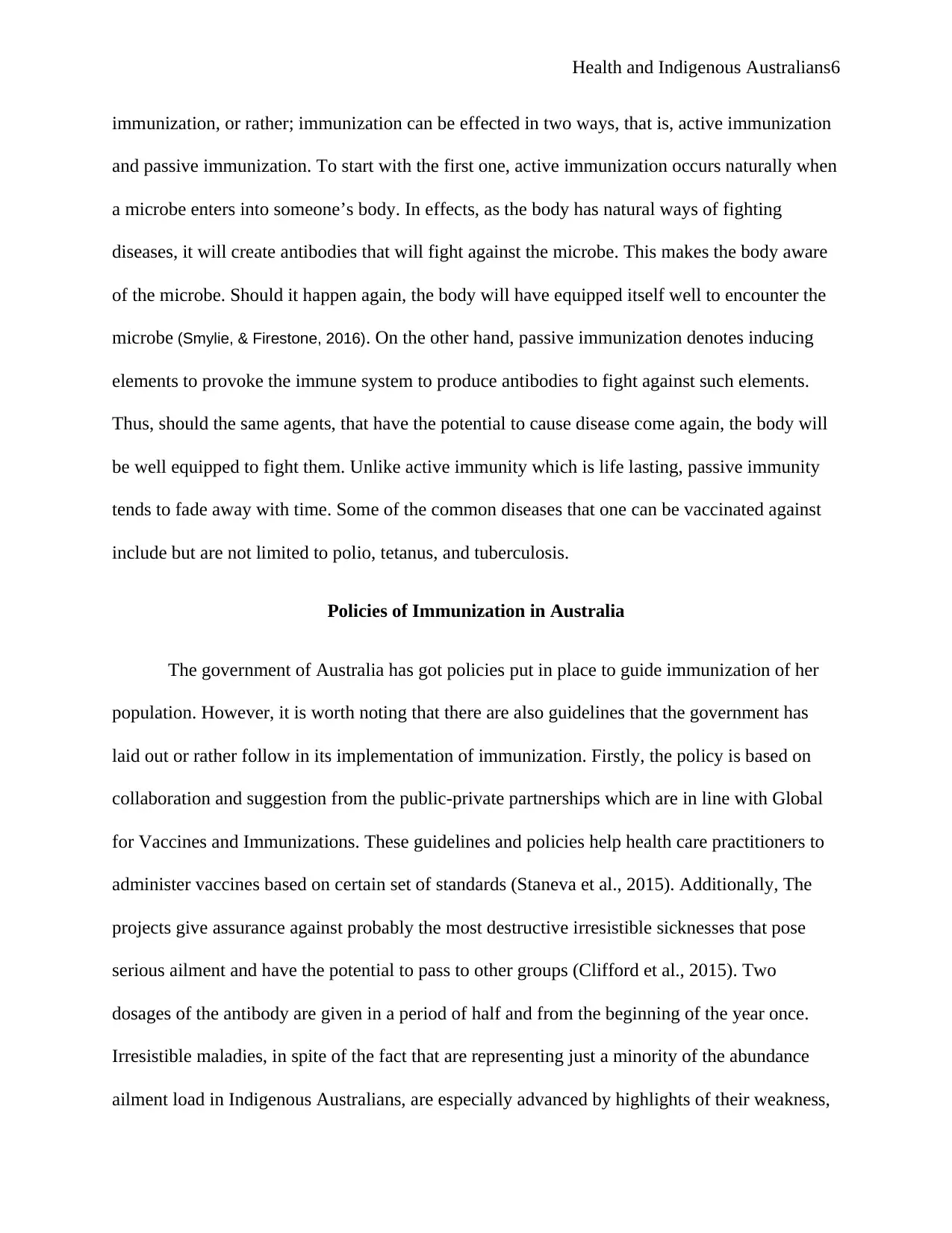
Health and Indigenous Australians6
immunization, or rather; immunization can be effected in two ways, that is, active immunization
and passive immunization. To start with the first one, active immunization occurs naturally when
a microbe enters into someone’s body. In effects, as the body has natural ways of fighting
diseases, it will create antibodies that will fight against the microbe. This makes the body aware
of the microbe. Should it happen again, the body will have equipped itself well to encounter the
microbe (Smylie, & Firestone, 2016). On the other hand, passive immunization denotes inducing
elements to provoke the immune system to produce antibodies to fight against such elements.
Thus, should the same agents, that have the potential to cause disease come again, the body will
be well equipped to fight them. Unlike active immunity which is life lasting, passive immunity
tends to fade away with time. Some of the common diseases that one can be vaccinated against
include but are not limited to polio, tetanus, and tuberculosis.
Policies of Immunization in Australia
The government of Australia has got policies put in place to guide immunization of her
population. However, it is worth noting that there are also guidelines that the government has
laid out or rather follow in its implementation of immunization. Firstly, the policy is based on
collaboration and suggestion from the public-private partnerships which are in line with Global
for Vaccines and Immunizations. These guidelines and policies help health care practitioners to
administer vaccines based on certain set of standards (Staneva et al., 2015). Additionally, The
projects give assurance against probably the most destructive irresistible sicknesses that pose
serious ailment and have the potential to pass to other groups (Clifford et al., 2015). Two
dosages of the antibody are given in a period of half and from the beginning of the year once.
Irresistible maladies, in spite of the fact that are representing just a minority of the abundance
ailment load in Indigenous Australians, are especially advanced by highlights of their weakness,
immunization, or rather; immunization can be effected in two ways, that is, active immunization
and passive immunization. To start with the first one, active immunization occurs naturally when
a microbe enters into someone’s body. In effects, as the body has natural ways of fighting
diseases, it will create antibodies that will fight against the microbe. This makes the body aware
of the microbe. Should it happen again, the body will have equipped itself well to encounter the
microbe (Smylie, & Firestone, 2016). On the other hand, passive immunization denotes inducing
elements to provoke the immune system to produce antibodies to fight against such elements.
Thus, should the same agents, that have the potential to cause disease come again, the body will
be well equipped to fight them. Unlike active immunity which is life lasting, passive immunity
tends to fade away with time. Some of the common diseases that one can be vaccinated against
include but are not limited to polio, tetanus, and tuberculosis.
Policies of Immunization in Australia
The government of Australia has got policies put in place to guide immunization of her
population. However, it is worth noting that there are also guidelines that the government has
laid out or rather follow in its implementation of immunization. Firstly, the policy is based on
collaboration and suggestion from the public-private partnerships which are in line with Global
for Vaccines and Immunizations. These guidelines and policies help health care practitioners to
administer vaccines based on certain set of standards (Staneva et al., 2015). Additionally, The
projects give assurance against probably the most destructive irresistible sicknesses that pose
serious ailment and have the potential to pass to other groups (Clifford et al., 2015). Two
dosages of the antibody are given in a period of half and from the beginning of the year once.
Irresistible maladies, in spite of the fact that are representing just a minority of the abundance
ailment load in Indigenous Australians, are especially advanced by highlights of their weakness,
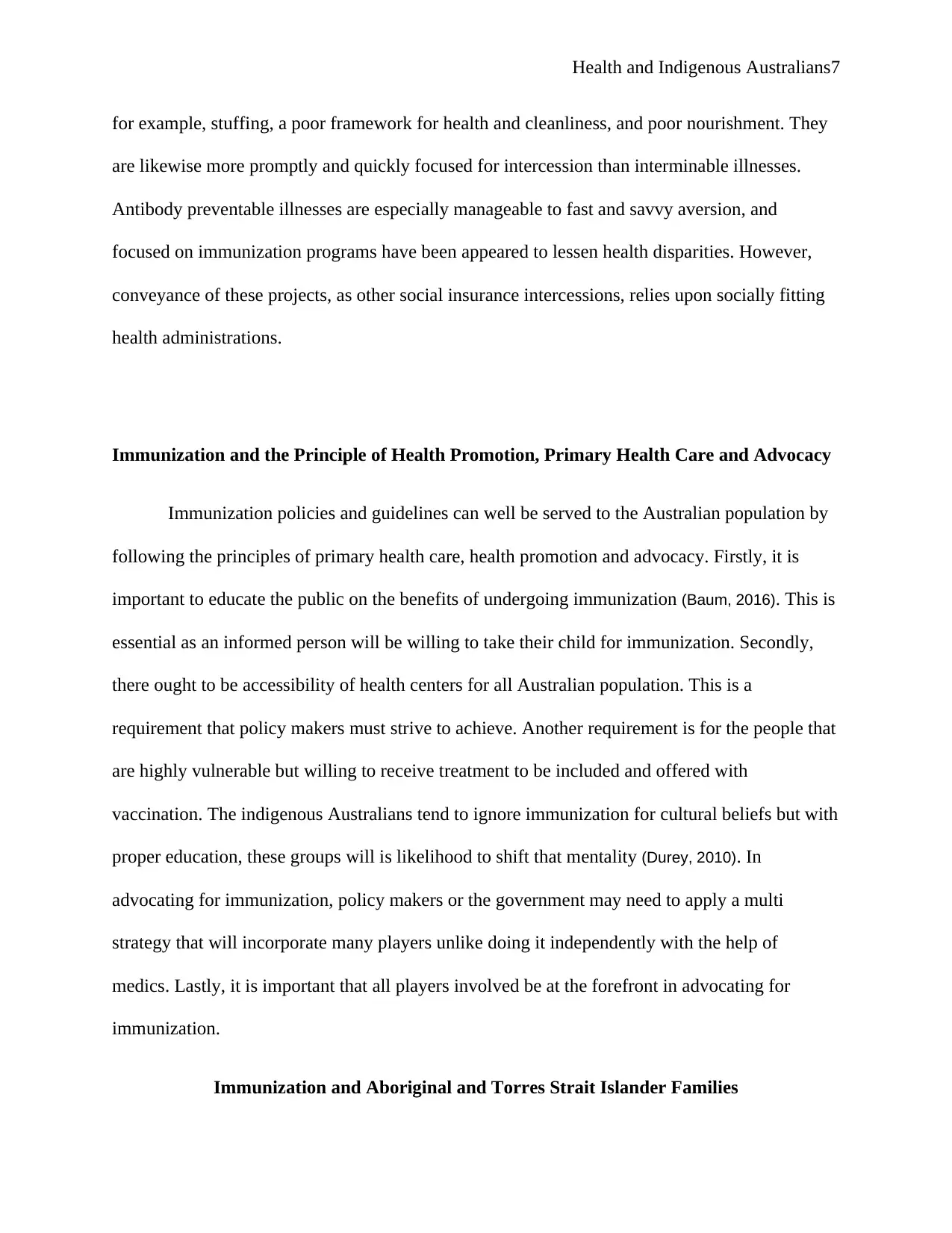
Health and Indigenous Australians7
for example, stuffing, a poor framework for health and cleanliness, and poor nourishment. They
are likewise more promptly and quickly focused for intercession than interminable illnesses.
Antibody preventable illnesses are especially manageable to fast and savvy aversion, and
focused on immunization programs have been appeared to lessen health disparities. However,
conveyance of these projects, as other social insurance intercessions, relies upon socially fitting
health administrations.
Immunization and the Principle of Health Promotion, Primary Health Care and Advocacy
Immunization policies and guidelines can well be served to the Australian population by
following the principles of primary health care, health promotion and advocacy. Firstly, it is
important to educate the public on the benefits of undergoing immunization (Baum, 2016). This is
essential as an informed person will be willing to take their child for immunization. Secondly,
there ought to be accessibility of health centers for all Australian population. This is a
requirement that policy makers must strive to achieve. Another requirement is for the people that
are highly vulnerable but willing to receive treatment to be included and offered with
vaccination. The indigenous Australians tend to ignore immunization for cultural beliefs but with
proper education, these groups will is likelihood to shift that mentality (Durey, 2010). In
advocating for immunization, policy makers or the government may need to apply a multi
strategy that will incorporate many players unlike doing it independently with the help of
medics. Lastly, it is important that all players involved be at the forefront in advocating for
immunization.
Immunization and Aboriginal and Torres Strait Islander Families
for example, stuffing, a poor framework for health and cleanliness, and poor nourishment. They
are likewise more promptly and quickly focused for intercession than interminable illnesses.
Antibody preventable illnesses are especially manageable to fast and savvy aversion, and
focused on immunization programs have been appeared to lessen health disparities. However,
conveyance of these projects, as other social insurance intercessions, relies upon socially fitting
health administrations.
Immunization and the Principle of Health Promotion, Primary Health Care and Advocacy
Immunization policies and guidelines can well be served to the Australian population by
following the principles of primary health care, health promotion and advocacy. Firstly, it is
important to educate the public on the benefits of undergoing immunization (Baum, 2016). This is
essential as an informed person will be willing to take their child for immunization. Secondly,
there ought to be accessibility of health centers for all Australian population. This is a
requirement that policy makers must strive to achieve. Another requirement is for the people that
are highly vulnerable but willing to receive treatment to be included and offered with
vaccination. The indigenous Australians tend to ignore immunization for cultural beliefs but with
proper education, these groups will is likelihood to shift that mentality (Durey, 2010). In
advocating for immunization, policy makers or the government may need to apply a multi
strategy that will incorporate many players unlike doing it independently with the help of
medics. Lastly, it is important that all players involved be at the forefront in advocating for
immunization.
Immunization and Aboriginal and Torres Strait Islander Families
Paraphrase This Document
Need a fresh take? Get an instant paraphrase of this document with our AI Paraphraser
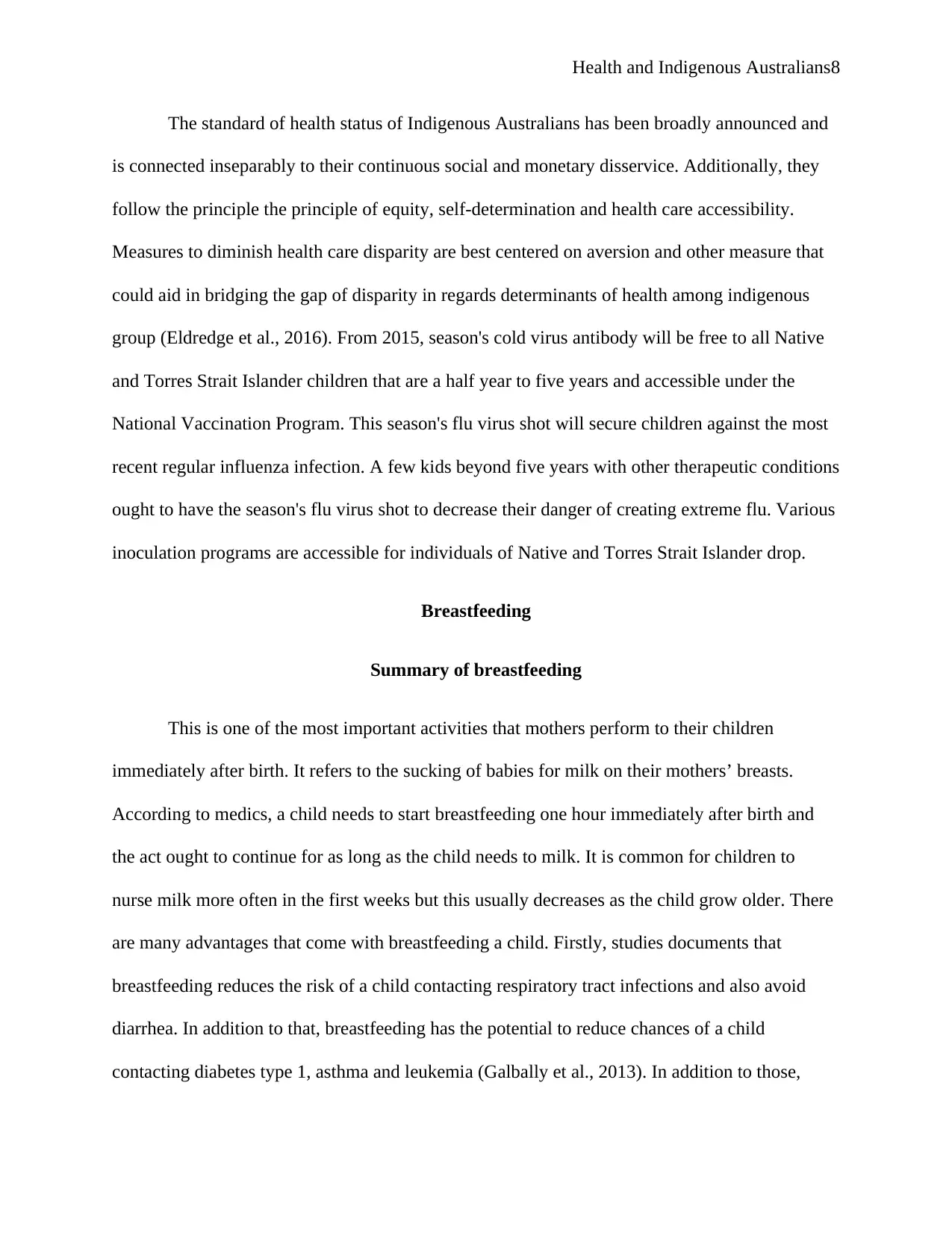
Health and Indigenous Australians8
The standard of health status of Indigenous Australians has been broadly announced and
is connected inseparably to their continuous social and monetary disservice. Additionally, they
follow the principle the principle of equity, self-determination and health care accessibility.
Measures to diminish health care disparity are best centered on aversion and other measure that
could aid in bridging the gap of disparity in regards determinants of health among indigenous
group (Eldredge et al., 2016). From 2015, season's cold virus antibody will be free to all Native
and Torres Strait Islander children that are a half year to five years and accessible under the
National Vaccination Program. This season's flu virus shot will secure children against the most
recent regular influenza infection. A few kids beyond five years with other therapeutic conditions
ought to have the season's flu virus shot to decrease their danger of creating extreme flu. Various
inoculation programs are accessible for individuals of Native and Torres Strait Islander drop.
Breastfeeding
Summary of breastfeeding
This is one of the most important activities that mothers perform to their children
immediately after birth. It refers to the sucking of babies for milk on their mothers’ breasts.
According to medics, a child needs to start breastfeeding one hour immediately after birth and
the act ought to continue for as long as the child needs to milk. It is common for children to
nurse milk more often in the first weeks but this usually decreases as the child grow older. There
are many advantages that come with breastfeeding a child. Firstly, studies documents that
breastfeeding reduces the risk of a child contacting respiratory tract infections and also avoid
diarrhea. In addition to that, breastfeeding has the potential to reduce chances of a child
contacting diabetes type 1, asthma and leukemia (Galbally et al., 2013). In addition to those,
The standard of health status of Indigenous Australians has been broadly announced and
is connected inseparably to their continuous social and monetary disservice. Additionally, they
follow the principle the principle of equity, self-determination and health care accessibility.
Measures to diminish health care disparity are best centered on aversion and other measure that
could aid in bridging the gap of disparity in regards determinants of health among indigenous
group (Eldredge et al., 2016). From 2015, season's cold virus antibody will be free to all Native
and Torres Strait Islander children that are a half year to five years and accessible under the
National Vaccination Program. This season's flu virus shot will secure children against the most
recent regular influenza infection. A few kids beyond five years with other therapeutic conditions
ought to have the season's flu virus shot to decrease their danger of creating extreme flu. Various
inoculation programs are accessible for individuals of Native and Torres Strait Islander drop.
Breastfeeding
Summary of breastfeeding
This is one of the most important activities that mothers perform to their children
immediately after birth. It refers to the sucking of babies for milk on their mothers’ breasts.
According to medics, a child needs to start breastfeeding one hour immediately after birth and
the act ought to continue for as long as the child needs to milk. It is common for children to
nurse milk more often in the first weeks but this usually decreases as the child grow older. There
are many advantages that come with breastfeeding a child. Firstly, studies documents that
breastfeeding reduces the risk of a child contacting respiratory tract infections and also avoid
diarrhea. In addition to that, breastfeeding has the potential to reduce chances of a child
contacting diabetes type 1, asthma and leukemia (Galbally et al., 2013). In addition to those,
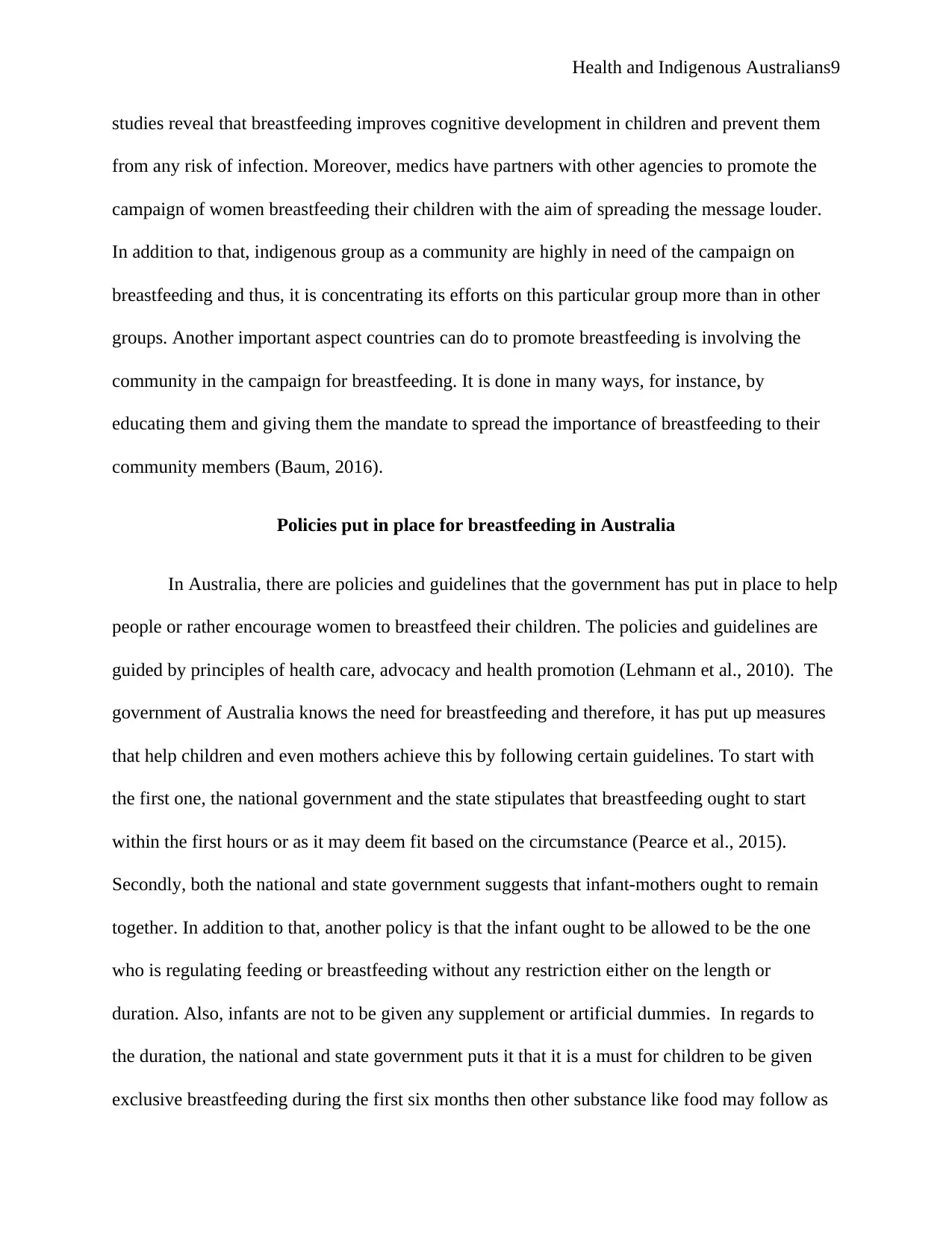
Health and Indigenous Australians9
studies reveal that breastfeeding improves cognitive development in children and prevent them
from any risk of infection. Moreover, medics have partners with other agencies to promote the
campaign of women breastfeeding their children with the aim of spreading the message louder.
In addition to that, indigenous group as a community are highly in need of the campaign on
breastfeeding and thus, it is concentrating its efforts on this particular group more than in other
groups. Another important aspect countries can do to promote breastfeeding is involving the
community in the campaign for breastfeeding. It is done in many ways, for instance, by
educating them and giving them the mandate to spread the importance of breastfeeding to their
community members (Baum, 2016).
Policies put in place for breastfeeding in Australia
In Australia, there are policies and guidelines that the government has put in place to help
people or rather encourage women to breastfeed their children. The policies and guidelines are
guided by principles of health care, advocacy and health promotion (Lehmann et al., 2010). The
government of Australia knows the need for breastfeeding and therefore, it has put up measures
that help children and even mothers achieve this by following certain guidelines. To start with
the first one, the national government and the state stipulates that breastfeeding ought to start
within the first hours or as it may deem fit based on the circumstance (Pearce et al., 2015).
Secondly, both the national and state government suggests that infant-mothers ought to remain
together. In addition to that, another policy is that the infant ought to be allowed to be the one
who is regulating feeding or breastfeeding without any restriction either on the length or
duration. Also, infants are not to be given any supplement or artificial dummies. In regards to
the duration, the national and state government puts it that it is a must for children to be given
exclusive breastfeeding during the first six months then other substance like food may follow as
studies reveal that breastfeeding improves cognitive development in children and prevent them
from any risk of infection. Moreover, medics have partners with other agencies to promote the
campaign of women breastfeeding their children with the aim of spreading the message louder.
In addition to that, indigenous group as a community are highly in need of the campaign on
breastfeeding and thus, it is concentrating its efforts on this particular group more than in other
groups. Another important aspect countries can do to promote breastfeeding is involving the
community in the campaign for breastfeeding. It is done in many ways, for instance, by
educating them and giving them the mandate to spread the importance of breastfeeding to their
community members (Baum, 2016).
Policies put in place for breastfeeding in Australia
In Australia, there are policies and guidelines that the government has put in place to help
people or rather encourage women to breastfeed their children. The policies and guidelines are
guided by principles of health care, advocacy and health promotion (Lehmann et al., 2010). The
government of Australia knows the need for breastfeeding and therefore, it has put up measures
that help children and even mothers achieve this by following certain guidelines. To start with
the first one, the national government and the state stipulates that breastfeeding ought to start
within the first hours or as it may deem fit based on the circumstance (Pearce et al., 2015).
Secondly, both the national and state government suggests that infant-mothers ought to remain
together. In addition to that, another policy is that the infant ought to be allowed to be the one
who is regulating feeding or breastfeeding without any restriction either on the length or
duration. Also, infants are not to be given any supplement or artificial dummies. In regards to
the duration, the national and state government puts it that it is a must for children to be given
exclusive breastfeeding during the first six months then other substance like food may follow as
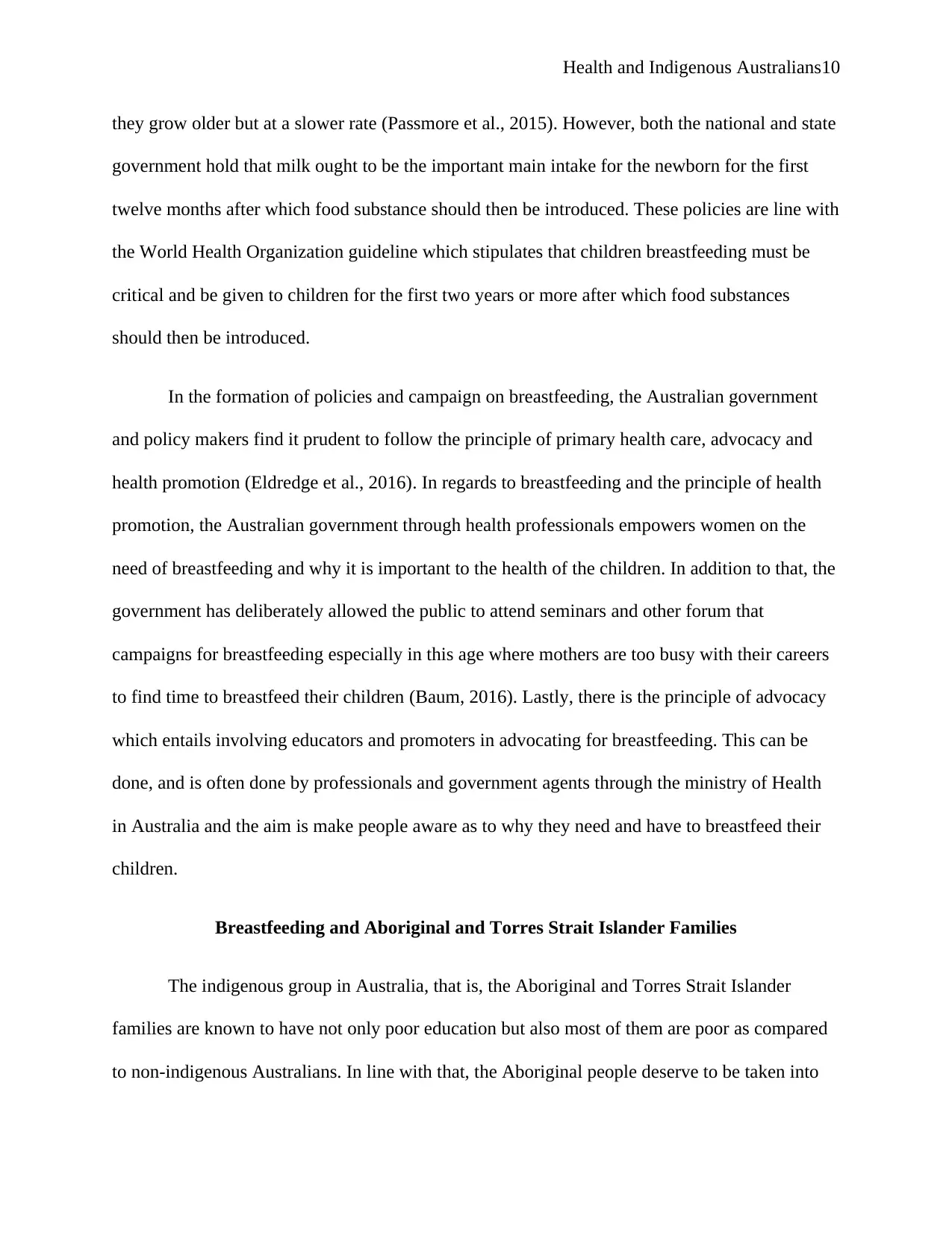
Health and Indigenous Australians10
they grow older but at a slower rate (Passmore et al., 2015). However, both the national and state
government hold that milk ought to be the important main intake for the newborn for the first
twelve months after which food substance should then be introduced. These policies are line with
the World Health Organization guideline which stipulates that children breastfeeding must be
critical and be given to children for the first two years or more after which food substances
should then be introduced.
In the formation of policies and campaign on breastfeeding, the Australian government
and policy makers find it prudent to follow the principle of primary health care, advocacy and
health promotion (Eldredge et al., 2016). In regards to breastfeeding and the principle of health
promotion, the Australian government through health professionals empowers women on the
need of breastfeeding and why it is important to the health of the children. In addition to that, the
government has deliberately allowed the public to attend seminars and other forum that
campaigns for breastfeeding especially in this age where mothers are too busy with their careers
to find time to breastfeed their children (Baum, 2016). Lastly, there is the principle of advocacy
which entails involving educators and promoters in advocating for breastfeeding. This can be
done, and is often done by professionals and government agents through the ministry of Health
in Australia and the aim is make people aware as to why they need and have to breastfeed their
children.
Breastfeeding and Aboriginal and Torres Strait Islander Families
The indigenous group in Australia, that is, the Aboriginal and Torres Strait Islander
families are known to have not only poor education but also most of them are poor as compared
to non-indigenous Australians. In line with that, the Aboriginal people deserve to be taken into
they grow older but at a slower rate (Passmore et al., 2015). However, both the national and state
government hold that milk ought to be the important main intake for the newborn for the first
twelve months after which food substance should then be introduced. These policies are line with
the World Health Organization guideline which stipulates that children breastfeeding must be
critical and be given to children for the first two years or more after which food substances
should then be introduced.
In the formation of policies and campaign on breastfeeding, the Australian government
and policy makers find it prudent to follow the principle of primary health care, advocacy and
health promotion (Eldredge et al., 2016). In regards to breastfeeding and the principle of health
promotion, the Australian government through health professionals empowers women on the
need of breastfeeding and why it is important to the health of the children. In addition to that, the
government has deliberately allowed the public to attend seminars and other forum that
campaigns for breastfeeding especially in this age where mothers are too busy with their careers
to find time to breastfeed their children (Baum, 2016). Lastly, there is the principle of advocacy
which entails involving educators and promoters in advocating for breastfeeding. This can be
done, and is often done by professionals and government agents through the ministry of Health
in Australia and the aim is make people aware as to why they need and have to breastfeed their
children.
Breastfeeding and Aboriginal and Torres Strait Islander Families
The indigenous group in Australia, that is, the Aboriginal and Torres Strait Islander
families are known to have not only poor education but also most of them are poor as compared
to non-indigenous Australians. In line with that, the Aboriginal people deserve to be taken into
Secure Best Marks with AI Grader
Need help grading? Try our AI Grader for instant feedback on your assignments.

Health and Indigenous Australians11
consideration in helping children and women breastfeed their children as far as the principles of
equity and access to health care are concerned. However, all this must be in line in respecting
their rights, that is, what they deem fit, also known as a right of self-determination (Coleman et
al., 2015). It is in so doing that Australia has come up with the National Breastfeeding Strategy
with various activities in place (Gould et al., 2015). In its policies, it borrows from Australian
Dietary Guidelines and international Organizations frameworks. Additionally, the guidelines are
from a broad range of expert opinions and peer-reviewed journals. On 1 July 2014, the
Australian Government set up the Indigenous Australians' Wellbeing Program, uniting four
existing subsidizing streams: essential human services financing, maternal health programs, and
more grounded Fates in the Northern Region and programs secured by the Native and Torres
Strait Islander Perpetual Sickness Store. The IAHP expects to enhance the strength of all Native
and Torres Strait Islander people groups through an assortment of focused exercises concentrated
on neighborhood health needs that are intended to accomplish health equity amongst Indigenous
and non-Indigenous Australians in tyke mortality and future (Duckett, & Willcox, 2015).
consideration in helping children and women breastfeed their children as far as the principles of
equity and access to health care are concerned. However, all this must be in line in respecting
their rights, that is, what they deem fit, also known as a right of self-determination (Coleman et
al., 2015). It is in so doing that Australia has come up with the National Breastfeeding Strategy
with various activities in place (Gould et al., 2015). In its policies, it borrows from Australian
Dietary Guidelines and international Organizations frameworks. Additionally, the guidelines are
from a broad range of expert opinions and peer-reviewed journals. On 1 July 2014, the
Australian Government set up the Indigenous Australians' Wellbeing Program, uniting four
existing subsidizing streams: essential human services financing, maternal health programs, and
more grounded Fates in the Northern Region and programs secured by the Native and Torres
Strait Islander Perpetual Sickness Store. The IAHP expects to enhance the strength of all Native
and Torres Strait Islander people groups through an assortment of focused exercises concentrated
on neighborhood health needs that are intended to accomplish health equity amongst Indigenous
and non-Indigenous Australians in tyke mortality and future (Duckett, & Willcox, 2015).

Health and Indigenous Australians12
References
Baum, F., 2016. The new public health (No. Ed. 4). Oxford University Press.
Bowes, J. and Grace, R., 2014. Review of early childhood parenting, education and health
intervention programs for Indigenous children and families in Australia.
Chrisopoulos, S., Harford, J.E. and Ellershaw, A., 2016. Oral health and dental care in
Australia: key facts and figures 2015. Australian Institute of Health and Welfare.
Clifford, A., McCalman, J., Bainbridge, R. and Tsey, K., 2015. Interventions to improve cultural
competency in health care for Indigenous peoples of Australia, New Zealand, Canada and the
USA: a systematic review. International Journal for Quality in Health Care, 27(2), pp.89-98.
Coleman, T., Chamberlain, C., Davey, M.A., Cooper, S.E. and Leonardi‐Bee, J., 2015.
Pharmacological interventions for promoting smoking cessation during pregnancy. The
Cochrane Library.
Duckett, S. and Willcox, S., 2015. The Australian health care system (No. Ed. 5). Oxford
University Press.
Durey, A., 2010. Reducing racism in Aboriginal health care in Australia: where does cultural
education fit?. Australian and New Zealand Journal of Public Health, 34(s1).
Eldredge, L.K.B., Markham, C.M., Ruiter, R.A., Kok, G. and Parcel, G.S., 2016. Planning
health promotion programs: an intervention mapping approach. John Wiley & Sons.
References
Baum, F., 2016. The new public health (No. Ed. 4). Oxford University Press.
Bowes, J. and Grace, R., 2014. Review of early childhood parenting, education and health
intervention programs for Indigenous children and families in Australia.
Chrisopoulos, S., Harford, J.E. and Ellershaw, A., 2016. Oral health and dental care in
Australia: key facts and figures 2015. Australian Institute of Health and Welfare.
Clifford, A., McCalman, J., Bainbridge, R. and Tsey, K., 2015. Interventions to improve cultural
competency in health care for Indigenous peoples of Australia, New Zealand, Canada and the
USA: a systematic review. International Journal for Quality in Health Care, 27(2), pp.89-98.
Coleman, T., Chamberlain, C., Davey, M.A., Cooper, S.E. and Leonardi‐Bee, J., 2015.
Pharmacological interventions for promoting smoking cessation during pregnancy. The
Cochrane Library.
Duckett, S. and Willcox, S., 2015. The Australian health care system (No. Ed. 5). Oxford
University Press.
Durey, A., 2010. Reducing racism in Aboriginal health care in Australia: where does cultural
education fit?. Australian and New Zealand Journal of Public Health, 34(s1).
Eldredge, L.K.B., Markham, C.M., Ruiter, R.A., Kok, G. and Parcel, G.S., 2016. Planning
health promotion programs: an intervention mapping approach. John Wiley & Sons.
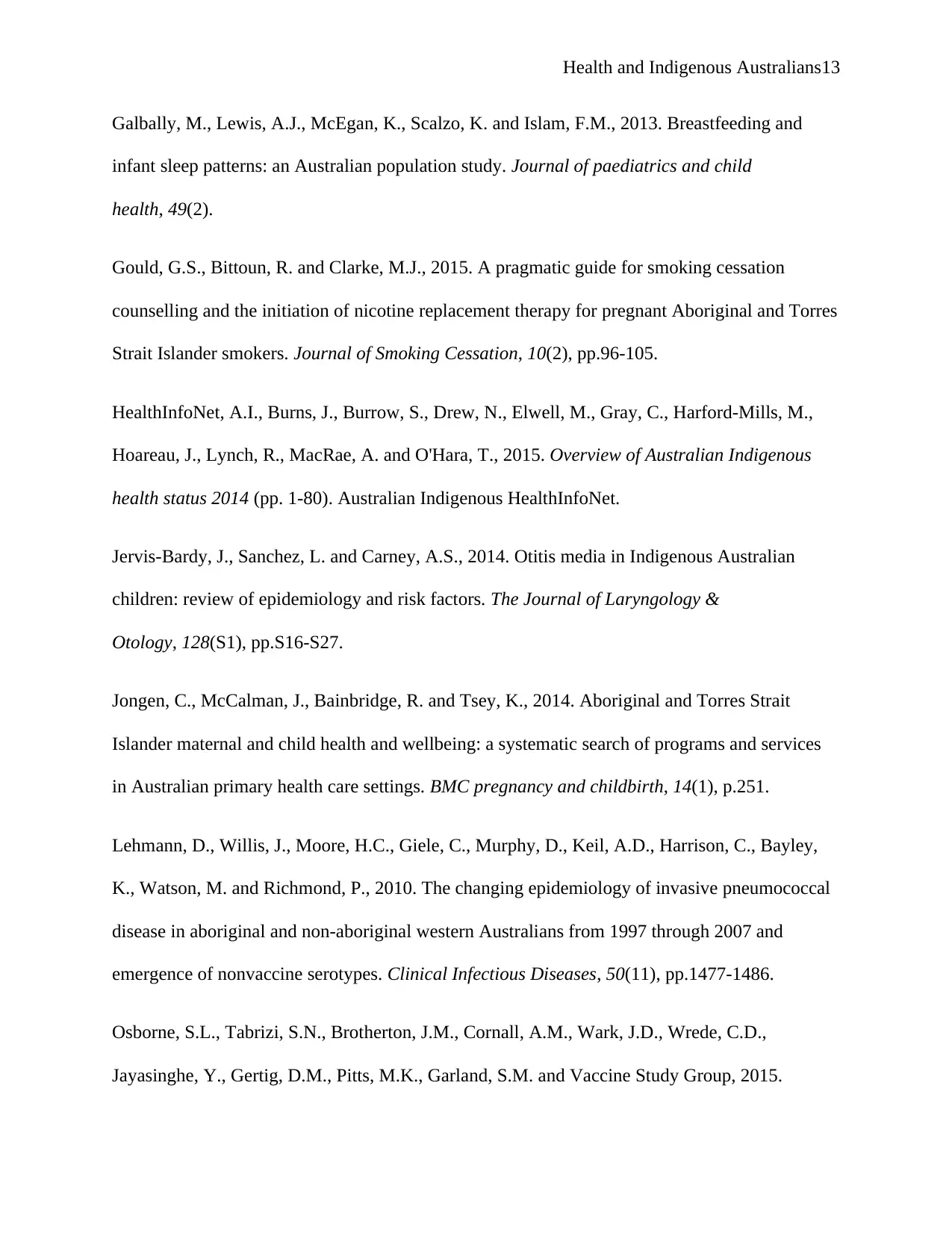
Health and Indigenous Australians13
Galbally, M., Lewis, A.J., McEgan, K., Scalzo, K. and Islam, F.M., 2013. Breastfeeding and
infant sleep patterns: an Australian population study. Journal of paediatrics and child
health, 49(2).
Gould, G.S., Bittoun, R. and Clarke, M.J., 2015. A pragmatic guide for smoking cessation
counselling and the initiation of nicotine replacement therapy for pregnant Aboriginal and Torres
Strait Islander smokers. Journal of Smoking Cessation, 10(2), pp.96-105.
HealthInfoNet, A.I., Burns, J., Burrow, S., Drew, N., Elwell, M., Gray, C., Harford-Mills, M.,
Hoareau, J., Lynch, R., MacRae, A. and O'Hara, T., 2015. Overview of Australian Indigenous
health status 2014 (pp. 1-80). Australian Indigenous HealthInfoNet.
Jervis-Bardy, J., Sanchez, L. and Carney, A.S., 2014. Otitis media in Indigenous Australian
children: review of epidemiology and risk factors. The Journal of Laryngology &
Otology, 128(S1), pp.S16-S27.
Jongen, C., McCalman, J., Bainbridge, R. and Tsey, K., 2014. Aboriginal and Torres Strait
Islander maternal and child health and wellbeing: a systematic search of programs and services
in Australian primary health care settings. BMC pregnancy and childbirth, 14(1), p.251.
Lehmann, D., Willis, J., Moore, H.C., Giele, C., Murphy, D., Keil, A.D., Harrison, C., Bayley,
K., Watson, M. and Richmond, P., 2010. The changing epidemiology of invasive pneumococcal
disease in aboriginal and non-aboriginal western Australians from 1997 through 2007 and
emergence of nonvaccine serotypes. Clinical Infectious Diseases, 50(11), pp.1477-1486.
Osborne, S.L., Tabrizi, S.N., Brotherton, J.M., Cornall, A.M., Wark, J.D., Wrede, C.D.,
Jayasinghe, Y., Gertig, D.M., Pitts, M.K., Garland, S.M. and Vaccine Study Group, 2015.
Galbally, M., Lewis, A.J., McEgan, K., Scalzo, K. and Islam, F.M., 2013. Breastfeeding and
infant sleep patterns: an Australian population study. Journal of paediatrics and child
health, 49(2).
Gould, G.S., Bittoun, R. and Clarke, M.J., 2015. A pragmatic guide for smoking cessation
counselling and the initiation of nicotine replacement therapy for pregnant Aboriginal and Torres
Strait Islander smokers. Journal of Smoking Cessation, 10(2), pp.96-105.
HealthInfoNet, A.I., Burns, J., Burrow, S., Drew, N., Elwell, M., Gray, C., Harford-Mills, M.,
Hoareau, J., Lynch, R., MacRae, A. and O'Hara, T., 2015. Overview of Australian Indigenous
health status 2014 (pp. 1-80). Australian Indigenous HealthInfoNet.
Jervis-Bardy, J., Sanchez, L. and Carney, A.S., 2014. Otitis media in Indigenous Australian
children: review of epidemiology and risk factors. The Journal of Laryngology &
Otology, 128(S1), pp.S16-S27.
Jongen, C., McCalman, J., Bainbridge, R. and Tsey, K., 2014. Aboriginal and Torres Strait
Islander maternal and child health and wellbeing: a systematic search of programs and services
in Australian primary health care settings. BMC pregnancy and childbirth, 14(1), p.251.
Lehmann, D., Willis, J., Moore, H.C., Giele, C., Murphy, D., Keil, A.D., Harrison, C., Bayley,
K., Watson, M. and Richmond, P., 2010. The changing epidemiology of invasive pneumococcal
disease in aboriginal and non-aboriginal western Australians from 1997 through 2007 and
emergence of nonvaccine serotypes. Clinical Infectious Diseases, 50(11), pp.1477-1486.
Osborne, S.L., Tabrizi, S.N., Brotherton, J.M., Cornall, A.M., Wark, J.D., Wrede, C.D.,
Jayasinghe, Y., Gertig, D.M., Pitts, M.K., Garland, S.M. and Vaccine Study Group, 2015.
Paraphrase This Document
Need a fresh take? Get an instant paraphrase of this document with our AI Paraphraser
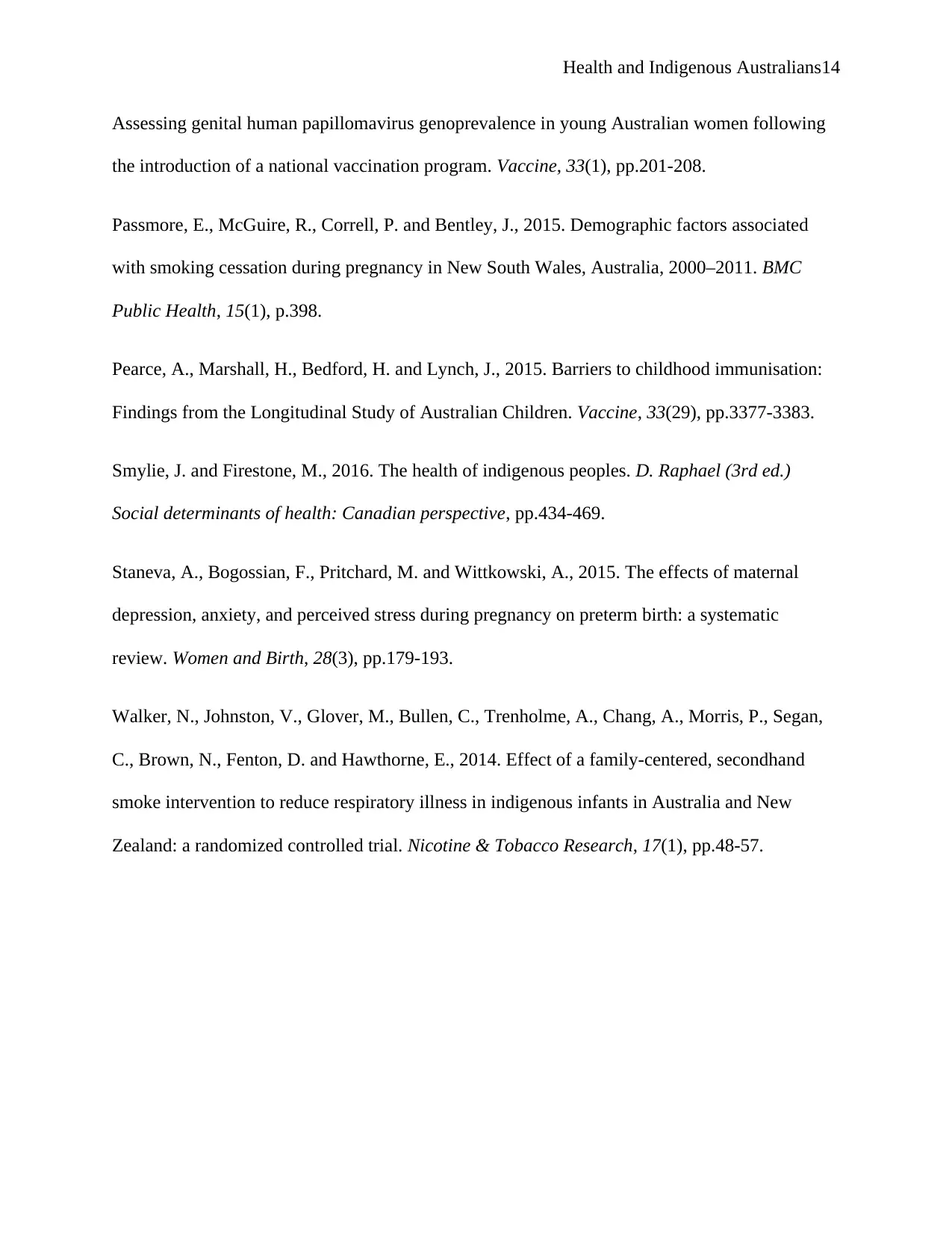
Health and Indigenous Australians14
Assessing genital human papillomavirus genoprevalence in young Australian women following
the introduction of a national vaccination program. Vaccine, 33(1), pp.201-208.
Passmore, E., McGuire, R., Correll, P. and Bentley, J., 2015. Demographic factors associated
with smoking cessation during pregnancy in New South Wales, Australia, 2000–2011. BMC
Public Health, 15(1), p.398.
Pearce, A., Marshall, H., Bedford, H. and Lynch, J., 2015. Barriers to childhood immunisation:
Findings from the Longitudinal Study of Australian Children. Vaccine, 33(29), pp.3377-3383.
Smylie, J. and Firestone, M., 2016. The health of indigenous peoples. D. Raphael (3rd ed.)
Social determinants of health: Canadian perspective, pp.434-469.
Staneva, A., Bogossian, F., Pritchard, M. and Wittkowski, A., 2015. The effects of maternal
depression, anxiety, and perceived stress during pregnancy on preterm birth: a systematic
review. Women and Birth, 28(3), pp.179-193.
Walker, N., Johnston, V., Glover, M., Bullen, C., Trenholme, A., Chang, A., Morris, P., Segan,
C., Brown, N., Fenton, D. and Hawthorne, E., 2014. Effect of a family-centered, secondhand
smoke intervention to reduce respiratory illness in indigenous infants in Australia and New
Zealand: a randomized controlled trial. Nicotine & Tobacco Research, 17(1), pp.48-57.
Assessing genital human papillomavirus genoprevalence in young Australian women following
the introduction of a national vaccination program. Vaccine, 33(1), pp.201-208.
Passmore, E., McGuire, R., Correll, P. and Bentley, J., 2015. Demographic factors associated
with smoking cessation during pregnancy in New South Wales, Australia, 2000–2011. BMC
Public Health, 15(1), p.398.
Pearce, A., Marshall, H., Bedford, H. and Lynch, J., 2015. Barriers to childhood immunisation:
Findings from the Longitudinal Study of Australian Children. Vaccine, 33(29), pp.3377-3383.
Smylie, J. and Firestone, M., 2016. The health of indigenous peoples. D. Raphael (3rd ed.)
Social determinants of health: Canadian perspective, pp.434-469.
Staneva, A., Bogossian, F., Pritchard, M. and Wittkowski, A., 2015. The effects of maternal
depression, anxiety, and perceived stress during pregnancy on preterm birth: a systematic
review. Women and Birth, 28(3), pp.179-193.
Walker, N., Johnston, V., Glover, M., Bullen, C., Trenholme, A., Chang, A., Morris, P., Segan,
C., Brown, N., Fenton, D. and Hawthorne, E., 2014. Effect of a family-centered, secondhand
smoke intervention to reduce respiratory illness in indigenous infants in Australia and New
Zealand: a randomized controlled trial. Nicotine & Tobacco Research, 17(1), pp.48-57.
1 out of 14
Related Documents
Your All-in-One AI-Powered Toolkit for Academic Success.
+13062052269
info@desklib.com
Available 24*7 on WhatsApp / Email
![[object Object]](/_next/static/media/star-bottom.7253800d.svg)
Unlock your academic potential
© 2024 | Zucol Services PVT LTD | All rights reserved.





